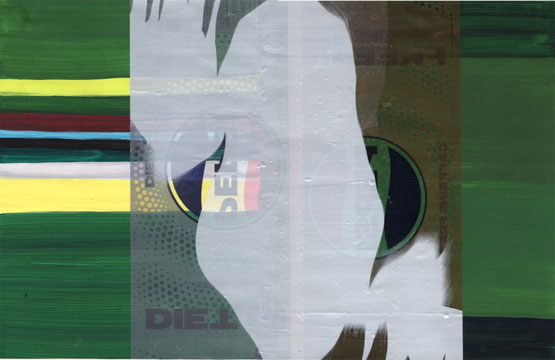
 |
Adjacent To Life, presents Scratch Frame Painting by Caroline Koebel. Curated by Mark Roth. Essay by Jennie Klein, Ph.D.
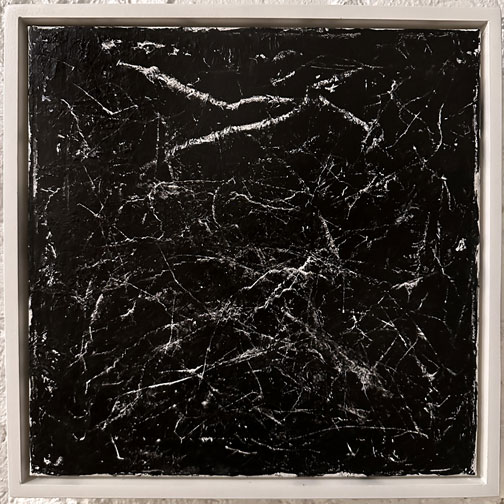
Caroline Koebel’s exhibition Scratch Frame Painting features 28 12x12 inch paintings from an ongoing series initiated in 2022. The intimate scale enables Koebel to make and store these paintings in her partner’s East Village studio/apartment and in her small 19th century home in Columbus. Koebel began her career as a filmmaker, writer and conceptual artist in the early 1990s. In comparison to her earlier work, Scratch Frame Painting is something of a departure.
Koebel has long been fascinated by analog technology and the historical processes and techniques in the development of photography and film. Her decision to use black and white acrylic paint recalls the experimental work of 19th and early 20th century photographers that included William Henry Fox Talbot, Anna Atkins, John Whipple Draper, and Barbara Morgan all of whom advanced the new technique of photography to make botanical, astronomical and scientific images. The look and feel of the paint frequently has a glossy texture that is similar to albumen prints, while the crispness of the lines and shapes is reminiscent of the detail in daguerreotypes.
The early days of photography were a wild west of experimentation with light, chemicals, developing, and printing fixed images of anything and everything. Quite a few of these photographs, including Atkins’s botanical contact photographs, Whipple Draper’s image of the moon, and Morgan’s images of nuclear fission, were very abstract. Scientific and medical photography were as important as photographic portraits and landscapes. Photomicrography, produced by using a daguerreotype camera that was stabilized over a microscope, yielded fantastic images of amoebas, viruses, bacteria, and other microscopic dangers that were not apparent to the naked eye. Photography was also mobilized slightly later as a tool for documenting surgical treatments including amputations, horrific injuries resulting from trench warfare, and rudimentary attempts at plastic surgery.
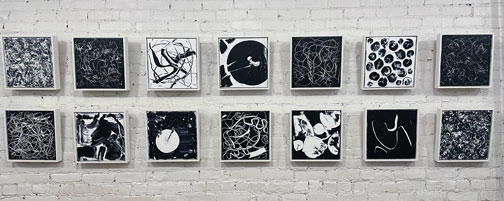
Koebel’s 28 paintings arranged as though they are two rolls of film have parallels with this early work, much of which was made prior to the invention of film. The artist’s process of applying layers of either black/white or white/black paint and then delving in with a palette knife or drywall tool is akin to photography by way of a simultaneously additive and subtractive action. Regarding how Koebel’s paintings become occasions for the investigation of the materiality of paint, Eva Hesse’s positing of material as both subject and object comes to mind. The synthetic paint reinforces the scientific/clinical feel; the forms produced are hard edged and clearly defined. They recall the equally hard edged and clearly defined photomicrographs as well as the glass slides that fixed (and killed) the microscopic subjects that were documented in the late 19th and early 20th centuries.
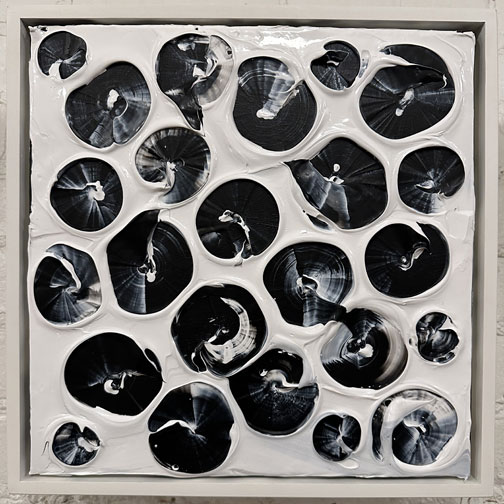
The variation in the surface of the paintings, a result of the generous use of paint, recalls the unruliness of Atkins’s contact print botanical cyanotypes, a wildness that had to be tamed to a contact print in order to prevent the picture from becoming too confusing and incomprehensible when translated into a two dimensional black and white image. Koebel’s abandon with the paint gestures as well to the excess of photography, an excess that is produced by the promise of the Real, even if that reality, as Roland Barthes argued persuasively in Camera Lucida, is already dead, an image of the past rather than the present. The ridges, the gouges and the unevenness invoke a previous moment in which the material was not fixed and remained malleable.
When seen altogether, there is something uncanny about Koebel’s stark black and white plastic paintings that are simultaneously sculptural and nonrepresentational. The disordered tectonics reverse the quiet eeriness of Man Ray’s Rayographs, spare arrangements of small objects that become monumental as they are translated into black and white contact images. Koebel does the opposite by removing the object and leaving only the traces of its mark. Scratch Frame Painting is about destruction and dissolution, a psychotic, corporeal break rather than a dreamlike hallucination.
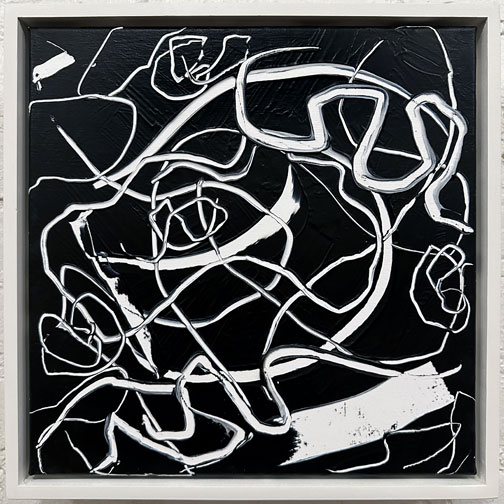
Koebel’s intervention recalls Late Modern artistic experiments with film that involved scratching, splicing and modifying the film itself, as seen in the work of Len Lye and Carolee Schneemann, both of whom viewed the film strip as another object whose surface they could manipulate, scratch and splice. Lye’s best known film, Free Radicals (1958), was created by scratching designs on 16mm black film leader with objects that included a dental tool and an ancient Native American arrowhead. The images were rather problematically synchronized to a field tape of the Bagirmi Tribe, whose lands border Lake Chad. Free Radicals won second prize at the 1958 World Fair in Brussels, a testament to the enduring power of the colonizing impulse in avant-garde art.
Carolee Schneemann’s 1971 Fuses, begun less than 10 years later, eschewed primitivism in favor of female eroticism from the perspective of Schneemann’s beloved cat Kitch (whose creations have been exhibited on this very same wall). The film depicts Schneemann and her then lover (and husband), composer James Tenney, joyfully making love for 29:51 minutes. Fuses was made as an homage to a man that Schneemann had lived with and loved for ten years. As a painter, Schneemann felt free to be even more experimental than Lye, examining the celluloid itself and fearlessly burning, baking, cutting, and painting it. Schneemann dipped her footage in acid and built collages from the layers of film, holding those layers together with paper clips. Fuses was filmed over three years with borrowed, wind-up Bolexes.
Not surprisingly, Koebel’s films are similarly manipulated, a combination of her own footage, found material and re-filmed images, which are seamed together with pastiched audio clips, film “noise” resembling the glitches found at the beginning of the film strip, and stroboscopic effects. Scratch Frame Painting can be read as a trajectory in Koebel’s artistic project, an extension of the films that Koebel made earlier. For hole or space (2006) a 3:22 color/black and white 16mm film (also available as a digital video) Koebel employs early cinema and avant-garde classics as compositional notes: Luis Martinetti, Contortionist (Edison Manufacturing Company, 1894); Crissie Sheridan Serpentine Dance (Edison, 1897); Ballet Mécanique (Fernand Léger & Dudley Murphy, 1924); An Optical Poem (Oskar Fischinger, 1938); Tarantella (Mary E. Bute & Ted Nemeth, 1940). Only two of these performances are recognizable as quotations: Edison Manufacturing Company’s circular film of contortionist Luis Martinetti (1894) and Crissie Sheridan’s 1897 Serpentine Dance, performed by making circular forms with her clothing. There are quite a few circles in this film, which conveys the rest of the footage with large circles, a lively yellow circle, and smaller revolving circles in formations that reference the more abstract work of Ballet Mécanique, An Optical Poem and Tarantella.
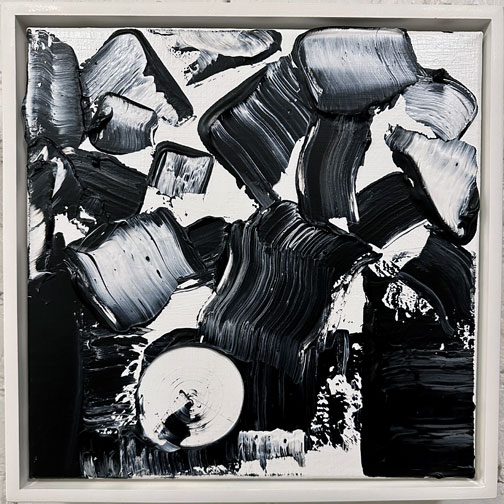
There are altogether 10 paintings featuring circular forms attained by pressing a tool into the paint layer and rotating it with varying degrees of force, opening passageways from the surface to the substrate. This is particularly evident in Scratch Frame Painting Overflow 3 (2023), where a circle is scraped out of paint that had overflowed off of the surface of another painting. Koebel collects these “overflows” in order to make paintings that like hole or space become pricks, dots, dashes, or openings spiraling out from the body–in this case the artist’s own body. In exploring how interiority is made visible by its external signature, Koebel’s paintings find congruency in the work of Ruth Asawa.
Koebel’s film Repeat Photography and the Albedo Effect (2008) repurposes Martin Scorsese’s black and white classic Raging Bull (1980) to address climate change and glacier melt. Using a Bolex 16mm camera, Koebel reshot the fight scenes, which she then hand processed and juxtaposed with National Public Radio reportage and Katie Paterson’s audio project, Vatnajökull (the sound of) (2008), made from the sounds of a melting glacier. The violent imagery of Raging Bull is followed by a blank white screen while the disembodied voice of an NPR reporter explains that the Mingyong Glacier, situated at the foot of the Khawa Karpo, a mountain named after the protective warrior God who took up residence in the mountain bearing his name, is rapidly retreating and likely to disappear by the end of the 21st century. Koebel’s film takes its title from the albedo effect, a process by which the glacier reflects the sun’s rays away from the earth, preventing it from overheating. The final portion of the film returns to the footage from Raging Bull, this time set to the trickling water sounds of Vatnajökull. The violence of the boxing match is mitigated by solarization, a reference to the power of the sun, whose destructiveness is belied by Paterson’s deceptively soothing soundpiece.
With Scratch Frame Painting, Koebel draws from Lye and Schneemann, embracing analog work and the marvel of film through direct means to mark and score the paintings. Schneemann deliberately made her 16mm film into an object that she could transgress. Koebel goes even further, retreating away from experimental film and back to painting, an art form that had been all but dismissed at the end of the 20th century.
Koebel’s film ethos conjures the unboundedness of bodies, which overflow the frames of the film just as melting water overflows edges, containers and barriers. A self-avowed FemAbEx artist, she is inspired by Abstract Expressionists Joan Mitchell and Lee Krasner. She is also influenced by the work of Amy Sillman, who embraces doubt, unknowability and intimacy in her oil paintings. Koebel is interested in “nature’s complex relations of randomness and patterning, order and chaos, energy and inertia, force and resistance.” She seeks to “embolden painting as a ground zero for such dualities.”
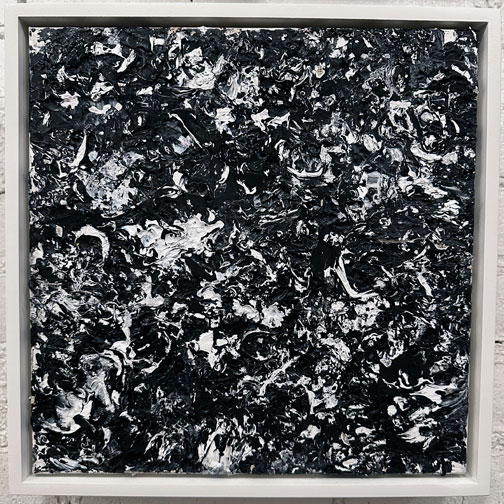
Like Schneemann, who came to film through Abstract Expressionism, Koebel probes the relationship between the actions of the body and the canvas, expanding the range of work past the borders of the canvas through her own agency. Whereas Schneemann’s journey began with male Abstract Expressionism and Pop Art, Koebel’s inquiry begins with the Pictures Generation, Postmodernity, Douglas Crimp (who curated Pictures), and Craig Owens (author of “The Discourse of Others: Feminists and Postmodernism”). There is excess in Koebel’s work, but it is controlled excess rather than the excesses of “primitive soundtracks,” oil paint and raw meat.
Brian Wallis’s 1984 anthology Art After Modernism: Rethinking Representation includes an essay by Thomas Lawson entitled “Last Exit: Painting.” In 1984, painting seemed to have run its course. Incapable of making grandiose statements and inspiring new art movements that might have been included on Alfred J. Barr’s 1936 chart of modern art, painting had become a last exit, a means by which Lawson could expose the fallacies of media representation, which for Lawson meant television and newspapers. In 2024, painting is no longer a last exit. Rather it is a new entry.
Making physical artworks has a very different meaning now than it did in the 1980s, an analog decade that saw itself as cutting edge. Today, embracing the analog is a radical strategy that eschews the plethora of social media noise in order to return to the purity of making. Koebel’s proliferating Scratch Frame Painting insists on taking up space. The discipline of Painting and Drawing is still alive and well in most art schools and universities. Lawson was wrong when he argued in 1984 that painting was a last exit. Instead, it has continued to be a productive entrance to craftsmanship, embodiment and meaning.
Jennie Klein, Ph.D.
Professor of Art History
Ohio University School of Art and Design
Jennie Klein writes about contemporary art, particularly as it intersects with feminism, new media, and performance. Her current project, Blessed Be, addresses the intersection of historical feminist art, Goddess feminism, and the urgency of climate change in contemporary art.
•
Scratch Frame Painting is on view through November 15, 2024 at the Adjacent To Life gallery housed in Ninth Street Espresso (341 E. 10th Street at Ave B, New York City). Artist's reception: Friday, October 18, 7:00 - 9:00 pm.
